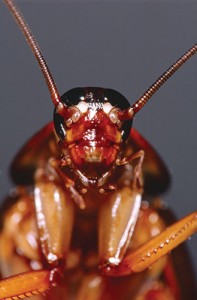
American Cockroach. Photo courtesy of, and copyrighted by, Gene White, pmimages@earthlink.net
American Cockroach
■ The American cockroach is the largest of the house-infesting cockroaches.
■ These cockroaches are reported to spread at least 33 kinds of bacteria, six kinds of parasitic worms and at least seven other kinds of human pathogens.
■ They can pick up germs on the spines of their legs and bodies while moving through decaying matter or sewage, and then carry these germs
to human food surfaces.
■ Medical studies show that cockroach allergens cause many allergic reactions, and sometimes asthma, in inner-city children. Allergens build up in the deposits of droppings, secretions, cast skins and dead bodies of roaches.
■ The American cockroach is most active at temperatures of 70 degrees or higher, but can survive lower temperatures under the right conditions.
German Cockroach
■ The German cockroach is an omnivorous scavenger.
■ They’re most interested in starchy, sugary foods, and grease and meats.
■ In a pinch, when there’s no food to be found, the German cockroach may eat household products including soap, glue and toothpaste. In dire straits they might even turn cannibalistic, munching on the wings and legs of one another.
Sources: pestworld.org, osu.edu
Leave A Comment